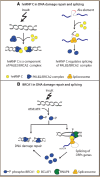The interplay between DNA damage response and RNA processing: the unexpected role of splicing factors as gatekeepers of genome stability
- PMID: 25926848
- PMCID: PMC4397863
- DOI: 10.3389/fgene.2015.00142
The interplay between DNA damage response and RNA processing: the unexpected role of splicing factors as gatekeepers of genome stability
Abstract
Genome integrity is constantly threatened by endogenous and exogenous factors. However, its preservation is ensured by a network of pathways that prevent and/or repair the lesion, which constitute the DNA damage response (DDR). Expression of the key proteins involved in the DDR is controlled by numerous post-transcriptional mechanisms, among which pre-mRNA splicing stands out. Intriguingly, several splicing factors (SFs) have been recently shown to play direct functions in DNA damage prevention and repair, which go beyond their expected splicing activity. At the same time, evidence is emerging that DNA repair proteins (DRPs) can actively sustain the DDR by acting as post-transcriptional regulator of gene expression, in addition to their well-known role in the mechanisms of signaling and repair of the lesion. Herein, we will review these non-canonical functions of both SFs and DRPs, which suggest the existence of a tight interplay between splicing regulation and canonical DNA safeguard mechanisms ensuring genome stability.
Keywords: DNA damage prevention; DNA repair; DNA repair proteins; RNA binding proteins; RNA metabolism; genome stability; splicing factors.
Figures


References
Grants and funding
LinkOut - more resources
Full Text Sources
Other Literature Sources

